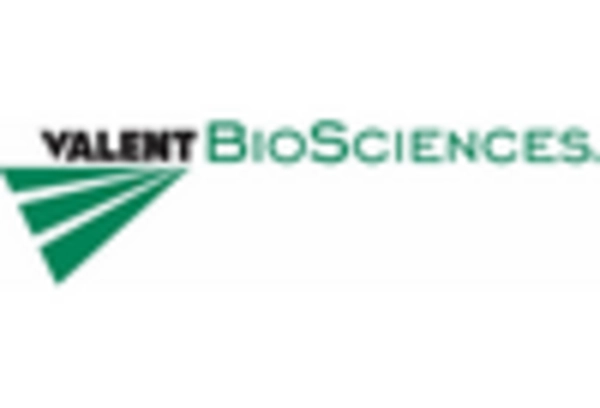Rising Demand for Organic Produce
The increasing consumer preference for organic produce is a notable driver in the Plant Hormones Market. As consumers become more health-conscious, the demand for organic fruits and vegetables has surged. This trend is likely to propel the use of plant hormones, which play a crucial role in enhancing crop yield and quality. According to recent data, the organic food market is projected to grow at a compound annual growth rate of approximately 10% over the next few years. This growth indicates a corresponding rise in the utilization of plant hormones to meet the quality standards expected by consumers. Consequently, the Plant Hormones Market is expected to expand as growers seek effective solutions to enhance their organic crop production.
Technological Advancements in Agriculture
Technological innovations in agriculture are significantly influencing the Plant Hormones Market. The integration of advanced technologies such as precision farming and biotechnology has enabled farmers to optimize the use of plant hormones. These advancements facilitate better monitoring of plant health and growth conditions, leading to more efficient hormone application. For instance, the use of drones and sensors allows for precise delivery of hormones, which can enhance crop performance. The market for agricultural technology is anticipated to reach substantial figures, indicating a robust growth trajectory. This trend suggests that as technology continues to evolve, the Plant Hormones Market will likely benefit from increased adoption of hormone-based solutions.
Climate Change and Its Impact on Agriculture
The effects of climate change are becoming increasingly apparent, and this phenomenon is driving changes in the Plant Hormones Market. As weather patterns become more unpredictable, farmers are seeking solutions to mitigate the adverse effects of climate variability on crop production. Plant hormones can play a vital role in helping crops adapt to stress conditions such as drought or excessive rainfall. The market for plant hormones is expected to grow as farmers look for ways to enhance crop resilience in the face of climate challenges. This trend indicates a potential shift in agricultural practices, with plant hormones becoming integral to strategies aimed at sustaining agricultural productivity.
Government Support for Agricultural Development
Government initiatives aimed at promoting agricultural development are a key driver in the Plant Hormones Market. Various countries are implementing policies that encourage sustainable farming practices and the use of agricultural inputs, including plant hormones. These policies often include subsidies, research funding, and educational programs designed to enhance crop productivity. For example, investments in agricultural research have led to the development of new plant hormone formulations that improve crop resilience and yield. As governments prioritize food security and sustainable agriculture, the Plant Hormones Market is expected to experience growth, driven by increased support for innovative agricultural practices.
Growing Awareness of Crop Management Techniques
The rising awareness of effective crop management techniques is influencing the Plant Hormones Market. Farmers are increasingly recognizing the benefits of using plant hormones to manage growth, flowering, and fruiting processes. This awareness is often driven by educational programs and agricultural extension services that highlight the advantages of hormone application. As a result, the market for plant hormones is projected to expand, with an increasing number of farmers adopting these techniques to enhance their crop yields. The emphasis on efficient crop management is likely to lead to a more widespread acceptance of plant hormones as essential tools in modern agriculture.


















Leave a Comment